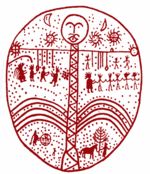Similar topics
"Rare Magic Inscription on Human Skull" -
Page 1 of 1
 "Rare Magic Inscription on Human Skull" -
"Rare Magic Inscription on Human Skull" -
See Biblical Archaeological Review for the complete article, which includes several images.
Not long ago, the well-known collector Shlomo Moussaieff acquired two earthenware bowls, the open ends of which were adjoined to form a kind of case—inside the case was an ancient human skull. A magic incantation, written in Aramaic, was inscribed on the skull.
BAR [Biblical Archaeological Review] readers already know about the more than two thousand magic incantation bowls that have survived from third–seventh-century C.E. Jewish communities in Babylonia.a The incantation bowls were made at the same time and in the very communities that produced the most intricate, complex and revered accomplishment of rabbinic Judaism, the Babylonian Talmud. Although some have deemed the incantation literature to be inconsistent with the spirit of the Talmud, recent research has shown it to be, rather, complementary and representative of aspects of life reflected within the Talmud.
The fact remains that belief in demons was widespread at this time among Jews as well as other peoples. Incantation bowls are known not only from Jewish communities but from other communities as well. The Jewish versions are written in what is commonly known as Jewish Aramaic.
To combat demons—who cause medical problems as well as other mishaps and ills—people invoked numerous magic rites and formulae. The magic rites could also serve as a love charm. Your desired one would surely fall in love with you if the proper incantation was invoked. The reverse was also true. To bring disaster on your personal enemy, you would invoke a curse text. These often-strange and mystifying incantations were usually inscribed in cramped writing in a spiral on the interior of the bowls.
Not all magic incantation texts were written on bowls. Sometimes they were written on parchment, tin, lead, copper, silver and even gold. Occasionally we find one on even more exotic materials such as eggs. Now from the Moussaieff collection comes one written on a skull.
It appears that only four other skulls with incantation texts have come to light—and a dim light at that. None of them was excavated professionally. All simply surfaced on the antiquities market.
And all but the Moussaieff skull have been known since the early 20th century. The great Aramaic scholar James A. Montgomery of the University of Pennsylvania studied one in the university’s museum collection, about which he wrote in 1913. When he examined it, the entire skull was there and well preserved, although in a shattered state. Montgomery reported two inscriptions on the skull. Unfortunately, the text was not very clear, and he managed only a few comments on the text. Even more unfortunate, the skull does not appear to have been well cared for since Montgomery’s time. Among the 17 remaining skull pieces I examined in Philadelphia—which were poorly mounted on a precarious wire structure with what appears to be something like epoxy glue—I found only what appears to be part of the shorter inscription. It is painfully clear that there is much less of the object at the present than there was when Montgomery examined it. And what is left of the skull appears to be in poor condition.
Montgomery’s comments on what he could salvage of the Philadelphia skull text indicate that it referred to “spirits” and “Liliths,” in the plural. In this period, high infant and birthing-mother mortality rates were attributed to Lilith demons, who were thought to roam the earth looking for pregnant women and newborn infants to attack. Lilith, of course, emerges later, in the medieval period, as the mythological first wife of Adam who refused to be subservient to him. But the motif of the demoness who roams the earth looking for newborn infants to devour has its roots in much-earlier Mesopotamian traditions and persists throughout history.
In addition to the Philadelphia skull, Montgomery mentioned two other skulls in the Berlin Museum that he was not able to examine. I noticed an additional skull at the Berlin Museum—so there are actually three, not two, specimens there. The texts on two of the three are extremely fragmentary. One fragmentary text, however, records the name of the powerful and sinister demon Yaror, the so-called “demon of dispatch” known from other incantation texts. This skull also contains a drawing of a bound demon, not dissimilar to the figures occasionally found in the incantation bowls. Perhaps this is Yaror himself.

ankh_f_n_khonsu- Number of posts : 545
Registration date : 2008-09-15
 Similar topics
Similar topics» "Turkey: Archeological Dig Reshaping Human History" -
» "The Human Consciousness Project" -
» "The Book of English Magic" by Carr-Gomm & Heygate -
» "The Human Consciousness Project" -
» "The Book of English Magic" by Carr-Gomm & Heygate -
Page 1 of 1
Permissions in this forum:
You cannot reply to topics in this forum
